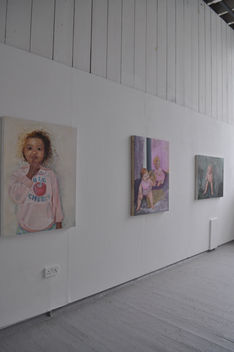8th-16th Jun 2013
SUGAR POP
GSA Degree Show Statement: June 2013
As a dance teacher, I am conflicted by ways in which children are objectified for adult enjoyment. The nature of preparing children to perform can raise questions for myself morally. For example, often toddlers are taught routines where they attempt to portray a sense of adulthood for the humour of the audience. This can include references to theatre productions/songs that when performed by adults have sexual undertones. Children are dressed in recognisable costumes and put on stage where they can be perceived as ridiculous, ‘cute’, and as a spectacle. The humour of these performances lie within the children’s inability to portray the adults that they reference. This may be because of the ‘innocence’ associated with their age.
The innocence associated with children has greatly influenced the conceptual tones in my practice and led to further research on how children are depicted, historically in painting and in modern media.
I engage with child morphology by replacing the familiar forms of the child with that of an adult to expose the role of a child as a spectacle to provide adult and visual pleasure.
This was demonstrated by figurative works displaying outfits/costumes worn by infants featuring fluffy frills, and animal costumes that symbolise purity/innocence, juxtaposed with old men and haunting faces. Through these methods I attempted to challenge the regular depiction of the child as a representation of ‘innocence’, exemplified by Sir Joshua Reynolds in Age of Innocence, or displayed in the photography of Ann Geddes. This may highlight the complexity of modern notions of ‘cuteness’ and the pertinence of the image of the child representing idealist virtues. Imagery of children, displaying the properties depicted by Reynolds, are constantly marketed and manufactured; and I question if they have been manipulated beyond repair. The depiction of children is often used in advertising to sell an ideology of family bliss, and consumed by the viewer, through an adult ‘gaze’. I have queries regarding ‘cuteness’ and it’s ridiculousness; and attempt to expose the weaknesses in an image used to uphold society’s virtues. I endeavour to reflect the anxious, media saturated society with an unease toward the use of depiction of the child. . With fantastical distortion of our reality I engage in a subject so very familiar yet fragile. Through this analysis of the child and its portrayal, I force the viewer to accept or reject their gaze upon the child and its distorted forms.











